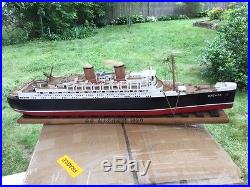
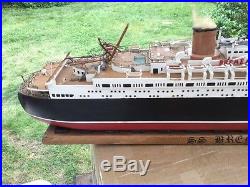

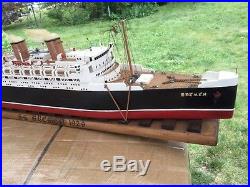
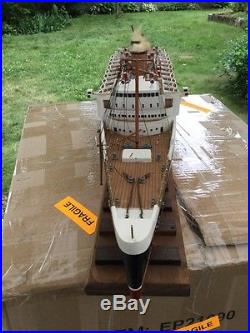
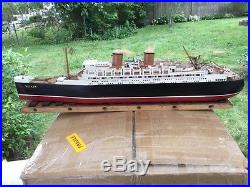
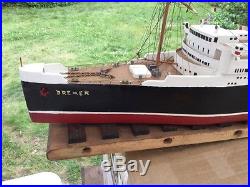
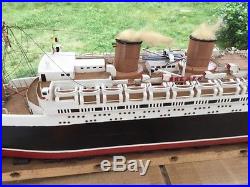
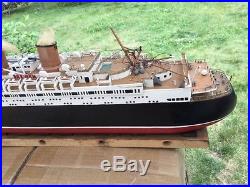

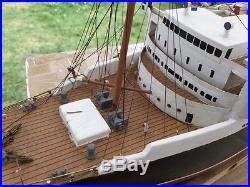
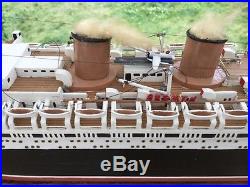

We acquired it from a local estate where the prior owner told us his grandfather built it from scratch. Loots of careful fine detail. I took 12 photos that helpfully show this magnificent steamship in close detail. Side is marked SS Bremen 1929 and end is marked Bremen Bremerhaven. Guaranteed genuine hand made as described; please use my photos to judge the overall condition. I will try hard to pack it carefully but being so delicate it may need some minor restoration. The SS Bremen was a German-built ocean liner constructed for the Norddeutscher Lloyd line (NDL) to work the transatlantic sea route. Bremen was notable for her bulbous bow construction, high-speed engines, and low, streamlined profile. The German pair sparked an international competition in the building of large, fast, luxurious ocean liners that were national symbols and points of prestige during the pre-war years of the 1930s. This speed enabled Norddeutscher Lloyd to run regular weekly crossings with two ships, a feat that normally required three. It was claimed that Bremen briefly reached speeds of 32 knots (59 km/h) during her sea trials. Bremen was built by the new German shipbuilding company Deutsche Schiff- und Maschinenbau. She was built from 7000 tons of high-strength steel with 52 kg/mm² (500 N/mm²), allowing a weight saving of some 800 tons on the structure. The high speeds and the comfort and luxury level on board made high demands of technical personnel. The boiler and the machine equipment were designed by Professor Dr. Bremen had four airtight boiler rooms. The combustion air for the oil burners of the boilers was blown into the boiler rooms by eight steam turbine blowers. The resulting positive pressure meant that the boiler rooms were only accessible through airlocks. The steam was generated in 20 oil-fired water tube boilers, eleven double-enders and nine single-enders in four banks fired by a total of 227 oil burners. The operating pressure was 23 atm = 24 bar with a steam temperature at the superheater discharge of 370 °C. The maximum steam generating capacity was 500 tons/h. For harbour operation three boilers with their own blower were available, so that during work periods the main boiler airlocks could remain open. The total heating surface amounted to 17,050 m ², the superheater surface 3,875 m ² and the air preheater surface 8,786 m ². The feed water was preheated to 130 °C and the fuel oil consumption was 33 tons/h or 380 g/HP/h or 800 tons/Day, fed from oil bunkers with a capacity of 7,552 tons. SS Bremen had four geared steam turbines that could generate approximately 135,000 sHP. Each of them had a high pressure, a medium pressure, low pressure and a reverse turbine. In reverse, 65% of the forward power was available. At cruise speed the turbines made 1800 rpm while the propellers made 180 rpm for a power output of 84,000 sHP. The four propellers were bronze and had a diameter of 5,000 mm, pitch of 5,200 mm and weighed 17 tons each. On board, there were total of 420 electric motors, approximately 21,000 lamps, electric cookers and 20 elevators. As Nazism gained power in Germany, Bremen and her pier in New York were often the site of Anti-Nazi demonstrations. On 26 July 1935 a group of communist demonstrators boarded Bremen just before she sailed and tore the Nazi flag from the jackstaff and tossed it into the Hudson River. At the time there was a dual flag law, by which both the black-white-red horizontal tricolour (previously the flag of the German Empire), and the swastika flag were simultaneously official national flags of Germany. On 15 September 1935 Germany changed its flag law, removing the status of the black-white-red flag of imperial Germany with which the Nazis on coming to power had replaced the black-red-gold flag of the Weimar Republic as co-national flag. On 22 August 1939, she began her last voyage to New York. After ten years of service, she had almost 190 transatlantic voyages completed. The item “Vintage Hand Made Folk Art Wooden Ship Model Steamship SS Bremen 1929 Not a Kit” is in sale since Sunday, June 12, 2016. This item is in the category “Antiques\Maritime\Model Ships”. The seller is “spooknook” and is located in Weymouth, Massachusetts. This item can be shipped worldwide.
